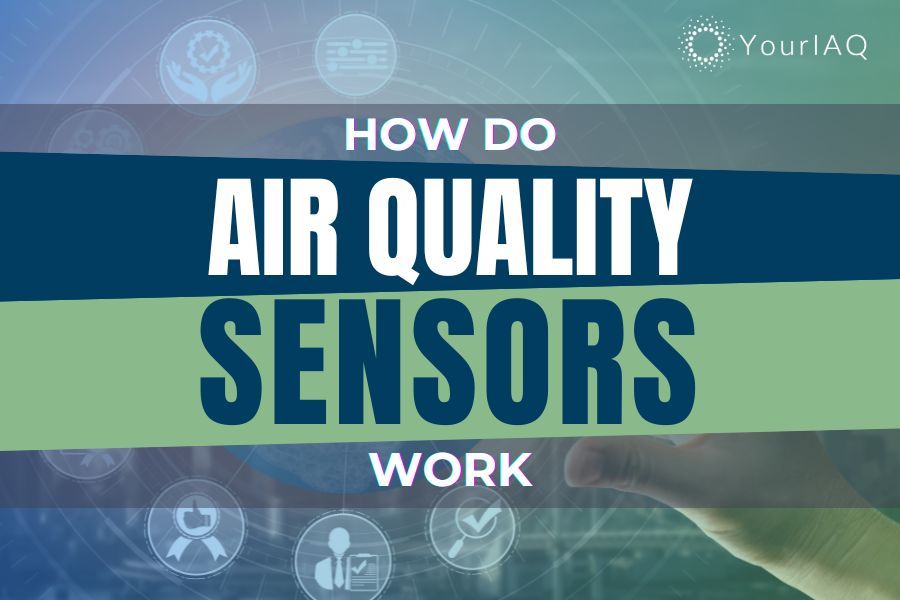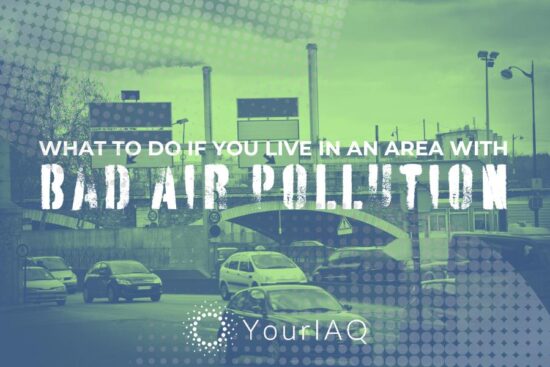
Have you ever wondered, “How do sensors work?” especially when it comes to monitoring the air we breathe? Those little monitors flashing green for “good” air and sending notifications when things go wrong don’t just rely on futuristic guesswork.
But why are these sensors so important?
Air quality sensors offer a window into the invisible world you breathe. Our homes are often havens for hidden indoor air pollutants. Cooking, cleaning, and even everyday activities introduce these pollutants. By providing real-time information about your indoor air quality, air quality sensors empower you to:
- Identify potential health risks
- Optimize your indoor environment
- Gain peace of mind
Whether you’re a homeowner, a health enthusiast, or someone curious about technology’s role in our well-being, this guide will shed light on how air quality sensors work!
What is an Air Quality Sensor?
Air quality sensors are devices designed to detect and measure concentrations of various pollutants in the air (particulate matter [PM1, PM2.5, PM10], VOCs, CO, CO2, NO2, SO2, O3, Pb, NH3, formaldehyde, radon (Rn), benzene, Polycyclic Aromatic Hydrocarbons [PAHs]) providing critical data on the quality of indoor and outdoor environments.
Some air quality sensors are designed to detect a single pollutant. However, there are also multi-pollutant sensors that can detect and measure concentrations of various air pollutants simultaneously.
IAQ by Sensables is an example of a multi-pollutant sensor. It can measure more than 20 indoor pollutants.
| IAQ: The Most Complete Indoor Air Quality Monitor (Sale price $249.99) | IAQ monitors for:
|
Multi-pollutant sensors offer the convenience of comprehensive monitoring with a single device, making them suitable for general indoor air quality assessments. In contrast, single-pollutant sensors are preferred for targeted monitoring or compliance with specific health and safety standards.
Air quality sensors also come in portable and stationary formats, designed to suit a variety of monitoring needs.
See also: Where IAQ Started: Origin of the First Device
How Air Quality Sensors Work
Air quality sensors are sophisticated devices that play a critical role in monitoring the composition of the air in indoor and outdoor environments. They employ various technologies to detect a wide range of pollutants, from particulate matter and volatile organic compounds (VOCs) to gases like carbon dioxide (CO2) and carbon monoxide (CO).
Here’s a simplified yet detailed look at how these sensors work and convert pollutant detections into readable data.
Sensing Technologies
The technology behind air quality sensors varies depending on the type of pollutant they’re designed to detect. Here are some common sensing methods:
Optical Particle Counters (OPCs)
OPC sensors detect particulate matter (PM) by illuminating the air sample with a light source, typically a laser. The choice of laser wavelength affects the sensor’s sensitivity to different particle sizes.
As air containing particulate matter passes through the laser beam, particles scatter the light in all directions. The pattern and intensity of the scattered light vary depending on the size and shape of the particles.
Photodetectors positioned at specific angles around the laser beam detect the scattered light. Advanced algorithms analyze the scattering pattern to differentiate between sizes of particles, allowing the OPC to categorize particulate matter into different classes, such as PM2.5 and PM10.
Metal Oxide Semiconductor (MOS)
Commonly used for detecting VOCs and some gases like CO, MOS sensors operate by heating a metal oxide film. At the heart of an MOS sensor is a film made from a metal oxide material, typically tin oxide (SnO2), tungsten oxide (WO3), or titanium dioxide (TiO2). When heated, this film is sensitive to certain gases.
The metal oxide film is heated to a specific operating temperature, usually between 200°C and 400°C, using an integrated heating element. When VOCs or gases come into contact with the heated film, they react, causing a change in the film’s electrical resistance. This change in resistance is measured and correlated with the concentration of the pollutants.
NOTE:
Higher concentrations of the gas lead to larger changes in resistance.
Non-Dispersive Infrared (NDIR) Sensors
These sensors are typically used for measuring CO2 levels. NDIR sensors work by emitting infrared light through a gas sample. Different gases absorb infrared light at specific wavelengths, and CO2 has its unique absorption band.
The sensor measures how much infrared light is absorbed by the CO2 in the air, which is then used to calculate the gas’s concentration.
Electrochemical Sensors
Ideal for detecting specific gases like CO and nitrogen dioxide (NO2), electrochemical sensors work through a chemical reaction that occurs when the target gas comes into contact with an electrode inside the sensor. The reaction produces an electrical current proportional to the concentration of the gas, allowing for precise measurements.
Data Conversion and Interpretation
Once the sensor detects pollutants and measures their concentration through one of the sensing technologies, the next step is to convert these measurements into readable data.
This process involves several steps:
- Signal Processing: The raw signals (light scattering, change in resistance, infrared absorption, or electrical current) are processed to filter out noise and improve accuracy. This involves amplification of the signal and conversion from analog to digital form if necessary.
- Calibration and Compensation: Sensors are calibrated against known standards to ensure accuracy. Additionally, compensation algorithms are applied to account for environmental factors such as temperature and humidity, which can affect sensor readings.
- Data Output: Finally, the processed and calibrated data is converted into a user-friendly format, such as parts per million (ppm) for gases or µg/m³ for particulate matter. Data are then displayed on the sensor’s interface, sent to a connected device like a smartphone or computer, or uploaded to a cloud service for further analysis.
Related reading: The Role of Data in Managing Indoor Air Quality
Sensor Accuracy and Calibration
Accurate sensors provide dependable data that inform critical decisions about health, safety, and comfort. Ensuring this accuracy involves proper calibration and an understanding of factors that may influence sensor readings.
2 Ways to Calibrate Sensors
Calibration is the process of adjusting a sensor’s measurements to match a known standard or reference. This ensures the sensor provides accurate readings of pollutant concentrations. Calibration is performed in two main ways:
Factory Calibration
Many sensors are pre-calibrated at the manufacturer, ensuring they meet specific accuracy standards before they reach consumers. This calibration is based on controlled conditions and known gas concentrations.
Field Calibration
Over time, sensors may drift from their original settings due to environmental factors or aging. Field calibration involves adjusting the sensor’s readings based on a known reference, which can be a controlled source of the pollutant or a secondary, more accurate sensor.
Some sensors are equipped with self-calibration features that automatically adjust based on ambient conditions.
4 Factors Affecting Sensor Readings
Several factors can influence the accuracy of air quality sensors, including:
- Environmental Conditions: Temperature, humidity, and air pressure can affect sensor performance. For example, humidity can interfere with particulate matter sensors, causing them to overestimate concentrations.
- Cross-Sensitivity: Some sensors may react to substances other than the target pollutant. For instance, a sensor designed to detect CO might also respond to hydrogen, leading to inaccurate readings.
- Aging and Wear: Sensors will degrade over time, leading to a drift in their accuracy. Regular maintenance and calibration are necessary to counteract this effect.
- Installation and Placement: Incorrect installation or placement can expose sensors to conditions that skew their readings, such as direct sunlight, drafts, or proximity to pollution sources.
Smart Home Integration Capabilities
Air quality sensors, when connected to a smart home system, automate various devices based on the detected levels of pollutants or environmental conditions. Here’s how it works:
HVAC System Control
If sensors detect high levels of CO2, indicating poor ventilation, the smart home system automatically adjusts the HVAC system to increase airflow and reduce CO2 concentrations.
Air Purifier Activation
When elevated levels of particulate matter (PM2.5 or PM10) or VOCs are detected, air quality sensors trigger air purifiers to turn on, filtering out harmful particles and chemicals from indoor air.
Humidifier/Dehumidifier Adjustment
Sensors monitoring humidity levels activate humidifiers or dehumidifiers to maintain optimal indoor humidity, preventing issues related to dry air or excessive moisture, such as mold growth.
Window and Vent Controls
In some advanced systems, air quality sensors interface with automated windows or vents, opening them to allow fresh air in when indoor air quality diminishes.
Related reading: From Detection to Action: Integrating IAQ with Home Automation
Types of Air Quality Sensors
Air quality sensors come in various forms, each specializing in detecting different airborne culprits. Understanding these types empowers you to choose the sensor that best suits your needs and provides a comprehensive picture of your indoor air quality.
Particulate Matter (PM) Sensors
Particulate matter sensors are designed to detect fine particles suspended in the air, specifically PM2.5 and PM10. PM2.5 refers to particles smaller than 2.5 micrometers, often resulting from combustion processes, while PM10 includes particles smaller than 10 micrometers, like dust and pollen.
PM sensors are essential for identifying airborne pollutants that penetrate deep into our respiratory system and cause health issues such as asthma, heart disease, and other respiratory ailments.
Key Metric:
- Look for safe levels recommended by your local authorities or organizations like the EPA (typically < 12 µg/m³). Higher readings indicate potential health risks and prompt action.
Volatile Organic Compounds (VOCs) Sensors
VOC sensors monitor the presence of volatile organic compounds, a group of chemicals that vaporize at room temperature and are found in everyday household products, from paints and varnishes to cleaning supplies and air fresheners.
Prolonged exposure to high levels of VOCs leads to health problems, including headaches, dizziness, and in severe cases, damage to the liver, kidney, and central nervous system. VOC sensors help in identifying and mitigating these invisible threats, ensuring a safer indoor environment.
Carbon Monoxide (CO) Sensors
Carbon monoxide is a colorless, odorless gas that is deadly at high concentrations. It’s produced by incomplete combustion from sources like stoves, heaters, and vehicles. CO sensors are critical for detecting the presence of this dangerous gas.
It can provide early warnings to prevent carbon monoxide poisoning, which can lead to symptoms like headaches, dizziness, nausea, and even death in extreme cases.
Key Metric:
- Ensure CO levels stay below 9 ppm for safety.
Carbon Dioxide (CO2) Sensors
While not as immediately dangerous as carbon monoxide, high levels of carbon dioxide indicate poor air circulation and poor ventilation in indoor spaces. CO2 sensors measure the concentration of carbon dioxide, helping to ensure that indoor environments have adequate fresh air exchange.
Proper CO2 levels are essential for maintaining comfort and reducing the risk of health issues related to poor air quality, such as headaches, lethargy, and difficulty concentrating.
Key Metric:
- Aim for CO2 levels below 1000 ppm for optimal indoor air quality.
Humidity and Temperature Sensors
Humidity and temperature play significant roles in indoor air quality. High humidity encourages the growth of mold and mildew, while low humidity causes respiratory irritation and discomfort. Temperature affects comfort levels and influences the concentrations of certain pollutants.
Sensors that monitor humidity and temperature help maintain a comfortable and healthy indoor environment, preventing conditions that could lead to health issues or discomfort.
How to Choose the Right Air Quality Sensor
Choosing the right air quality sensor is crucial for effectively monitoring the air in your home or workplace and making informed decisions to improve indoor air quality. Here are key factors to consider when selecting an air quality sensor, including features, reliability, and price points.
Target Pollutants
Identify the specific pollutants you want to monitor, such as particulate matter (PM2.5, PM10), volatile organic compounds (VOCs), carbon dioxide (CO2), carbon monoxide (CO), or a combination of these. Ensure the sensor you choose is designed to detect the types of pollutants of concern in your environment.
Sensor Accuracy and Sensitivity
Look for sensors with high accuracy and sensitivity to ensure reliable readings. Check the sensor’s specifications for its detection range and resolution. Sensors provide information on their margin of error, which can give you an idea of how precise the measurements will be.
Calibration and Maintenance
Understand how the sensor is calibrated and what maintenance it requires to maintain accuracy over time. Some sensors come with self-calibration features, which can be convenient for ensuring long-term reliability. Learn the maintenance procedures, such as sensor cleaning or replacement, to keep the device functioning properly.
Connectivity and Integration
Determine whether you need a standalone sensor or one that integrates with other smart home devices. Many modern air quality sensors offer Wi-Fi or Bluetooth connectivity, allowing you to monitor readings via a smartphone app and receive alerts.
Integration with smart home systems can enable automated actions based on air quality readings, such as activating air purifiers or adjusting ventilation.
Data Logging and Analysis
The ability to log and analyze air quality data over time can be invaluable for identifying trends and making informed decisions. Look for sensors that offer data logging features and easy-to-use apps or software for data analysis. This can help you understand when and why air quality changes occur, guiding effective interventions.
Ease of Use and Display
Consider the user interface and how the sensor displays its readings. A clear and intuitive display, whether on the device itself or through an app, can make it easier to quickly understand your air quality at a glance. Some sensors also provide color-coded indicators or other visual cues to signify air quality levels.
Price Points and Budget
Air quality sensors can vary widely in price, from affordable models that monitor a limited range of pollutants to high-end devices with advanced features and greater accuracy. Determine your budget and consider which features are most important for your needs.
Investing in a more expensive sensor that offers higher accuracy, reliability, and functionality might provide better long-term value.
Reviews and Recommendations
Before making a purchase, research reviews and recommendations from other users and reputable sources. User reviews can provide insights into the sensor’s performance in real-world conditions, while professional evaluations help assess its accuracy and reliability.
Installation and Maintenance Tips
Proper installation and maintenance are key to ensuring that air quality sensors provide accurate and reliable readings over time. Here are practical tips for both installing your sensors and keeping them well-maintained.
Installation Tips
- Choose the Right Location: Install sensors away from direct sources of pollutants, such as stoves, chimneys, or exhaust vents, to avoid skewed readings. Also, avoid placing sensors near windows or doors where drafts introduce outdoor air, which can affect the readings.
- Consider Occupant Activity: Install sensors at breathing height (about 3 to 6 feet from the floor) in areas where occupants spend the most time, such as living rooms, bedrooms, or offices, to get a representative sample of the air quality affecting individuals.
- Avoid Obstructions: Ensure the sensor’s air inlet and outlet are not obstructed by furniture, curtains, or other objects that could impede airflow and lead to inaccurate measurements.
- Mind the Environmental Conditions: Avoid placing sensors in areas subject to extreme temperatures, humidity, or direct sunlight, as these affect sensor performance and accuracy.
- Central Locations for General Monitoring: For a broad overview of indoor air quality, place sensors in central locations within your home or office, such as hallways or common rooms.
Maintenance Tips
- Follow Manufacturer’s Instructions: Each sensor may have specific maintenance requirements. Always refer to the manufacturer’s guidelines for cleaning, recalibrating, and other maintenance procedures.
- Regular Cleaning: Dust and debris can clog sensor inlets and affect readings. Use a soft brush or compressed air to gently clean the sensor’s exterior and any accessible parts according to the manufacturer’s recommendations.
- Calibration: Check if your sensor needs manual calibration and perform it as recommended. Some modern sensors calibrate automatically or alert you when calibration is needed.
- Firmware and Software Updates: For sensors that connect to smartphones or smart home systems, keep the device’s firmware and any associated apps updated. Updates improve sensor performance, add new features, and fix bugs.
- Battery Replacement or Charging: For portable or wireless sensors, regularly check and replace batteries or charge the device to ensure it’s always operational.
- Check for Wear and Tear: Inspect your sensor periodically for signs of wear or damage. If you notice any issues, consult the manufacturer’s support for advice or repairs.
- Document Maintenance and Calibration: Record all maintenance and calibration activities. This will help you track the sensor’s performance over time and identify when it might be time for replacement or professional servicing.
The Future of Air
Air quality sensors are more than just devices; they represent a shift towards a more proactive approach to air quality management. As technology advances and sensors become more affordable and versatile, their impact will continue to grow.
Imagine personalized air quality reports delivered to your phone, smart homes adjusting ventilation based on real-time data, and cities using sensor networks to predict and prevent pollution events. Studies show that using air quality sensors in schools reduces asthma symptoms. Cities using sensor networks have reported significant reductions in air pollution levels thanks to data-driven policies and interventions.
By empowering individuals and communities with air quality knowledge, we can collectively breathe easier and create a healthier future for ourselves and the planet.
Frequently Asked Questions
Can air quality sensors detect all types of pollutants?
Most sensors are designed to detect specific pollutants, such as particulate matter, VOCs, CO2, and CO. No single sensor can detect all pollutants, so it’s important to choose one that suits your needs.
Are air quality sensors expensive?
Prices vary depending on features and accuracy. Affordable options exist, but remember, you get what you pay for. Invest in a sensor meeting established standards for reliable data.
Are air quality sensors difficult to install?
No, most air quality sensors are user-friendly and can be easily installed following the manufacturer’s instructions. Some can be simply placed on a shelf or mounted on a wall.
Can I connect my air quality sensor to my smartphone?
Many modern air quality sensors come with smartphone connectivity, allowing you to monitor your indoor air quality in real-time through an app.
Do air quality sensors work in outdoor environments?
While designed primarily for indoor use, some air quality sensors are suitable for outdoor use. Check the product specifications for outdoor compatibility.
How often should I calibrate my air quality sensor?
Calibration frequency depends on the sensor model and usage. Refer to the manufacturer’s recommendations, but generally, once a year is a good practice.
Do I need multiple sensors for my home?
One strategically placed sensor can provide a good overview. Consider additional sensors for rooms with potential air quality concerns, such as kitchens or bathrooms.






